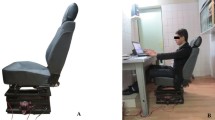Abstract
The objective of the present study is to find out the effect of the operator, the mine room and their interaction on the vibration measured on a scaling machine. Vibration measurements were conducted for three different mine rooms and three different drivers. The vector sum value of the root-mean-square acceleration, the vector sum value of the acceleration dose and the kurtosis sum were utilized to quantify the measured vibration. The unbalanced two-way ANOVA and the Kramer–Tukey test were utilized for the statistical analysis. The results show that the operating styles of the drivers in performing scaling activity and their interaction with the mine rooms have no significant effect on the vector sum value of the acceleration, the vector sum value of the acceleration dose and the kurtosis sum value. The mine rooms have a significant effect on the kurtosis sum value and the vector sum value of the acceleration dose, but not on the vector sum value of the acceleration.





Similar content being viewed by others
References
Board M, Krauland N, Sandström S, Resengren L (1992) Analysis of ground support methods at the Kristineberg mine in Sweden. In: Kaiser PK, McCreath DR (eds) Rock support in mining and underground construction. AA Balkema Publishers, Rotterdam
Boliden Mineral AB (2009) New boliden way. Boliden Mineral AB, Sweden
De Treville S, Antonakis J, Edelson NM (2005) Can standard operating procedures be motivating? Reconciling process variability issues and behavioural outcomes. Total Qual Manag 16(2):231–241
Dunstan K, Lavin B, Sandford R (2006) The application of lean manufacturing in a mining environment. In: Proceedings of the international mine management conference, Melbourne, Australia, 16–18 Oct
Edelbro C, Sandström D (2009) Interpretation of failure and fallouts based on numerical modelling of an underground mine stope. In: Proceedings of international symposium on rock mechanics: rock characterization, modelling and engineering design methods (SINOROCK 2009), Hongkong, China, 19–22 May
Edelson NM, Bennet CL (1998) Process discipline: how to maximize profitability and quality through manufacturing consistency. Productivity Press, New York
Grau RH, Prosser LJ (1997) Scaling accidents in underground stone mines. Rock Prod 100:39–41
Hall AS, McAree PR (2005) A study of the interaction between operator style and machine capability for a large hydraulic excavator. Proc of the Inst of Mech Eng C 219(5):477–489
Jon CY, Detty RB, Sottile J Jr (2000) Lean manufacturing principles and their applicability to the mining industry. Miner Resour Eng 9(2):215–238
Klippel AF, Petter CO, Antunes JAV Jr (2008) Management innovation, a way for mining companies to survive in a globalized world. Util Policy 16:332–333
Krauland N, Marklund P, Board M (2001) Rock support in cut-and-fill mining at the Kristineberg Mine. In: Hustrulid WA, Bullock RL (eds) Underground mining methods: engineering fundamentals and international case studies. Society for Mining, Metallurgy and Exploration Inc, Littleton
Lalanne C (2009a) Mechanical vibration and shock analysis, volume 3: random vibration, 2nd edn. Wiley, New Jersey
Lalanne C (2009b) Mechanical vibration and shock analysis, volume 4: fatigue damage, 2nd edn. Wiley, New Jersey
Lee KW, Tillman FA, Higgins JJ (1988) A literature survey of the human reliability component in a man-machine system. IEEE Trans Reliab 37(1):24–34
Levinthal DA, March JG (1993) The myopia of learning. Strateg Manag J 14:95–112
Li C (2005) Ground control of a mine stope in weak rocks subjected to high in situ stresses—a case study. In: Proceedings of 24th international conference on ground control in mining, West Virginia, USA, 2–4 Aug
Montgomery DC (2001) Design and analysis of experiments, 5th edn. Wiley, New York
Patnayak S, Tannant DD, Parsons I, Del Valle V, Wong J (2008) Operator and dipper tooth influence on electric shovel performance during oil sands mining. Int J Min Reclam Environ 22(2):120–145
Pew RW, Mavor AS (1998) Modeling human and organizational behavior: application to military simulations. National Academy Press, Washington
Quinteiro C, Quinteiro M, Hedstrom O (2001) Underground iron ore mining at LKAB, Sweden. In: Hustrulid WA, Bullock RL (eds) Underground mining methods: engineering fundamentals and international case studies. Society for Mining, Metallurgy and Exploration, Littleton
Rådberg G, Nordlund E, Nyström A (1992) Case study on the determination of input data for numerical modeling at the Kristineberg mine. In: Hudson JA (ed) Rock characterization. British Geotechnical Society, London
Rutherford A (2001) Introducing ANOVA and ANCOVA: a GLM approach. SAGE, London
Sait AS, Sharaf-Eldeen YI (2011) A review of gearbox condition monitoring based on vibration analysis techniques diagnostics and prognostics. In: Proulx T (ed) Machinery, structural health monitoring, shock and vibration, vol 5. Springer, New York
Suzaki K (1993) The new shop floor management: empowering people for continuous improvement. The Free Press, New York
Wijaya AR and Lundberg J (in press) Whole-body vibration-exposure due to a scaling machine. Int J Occup Saf Ergon
Wijaya AR, Kumar R, Kumar U (2009) Implementing lean principle into mining industry issues and challenges. In: Proceedings of the international symposium on mine planning and equipment selection (MPES 2009), Banff, Canada, 16–19 Nov
Acknowledgments
The authors would like to thank the Swedish Foundation for Strategic Research (SSF), Boliden Mineral AB and Jama Mining Machine AB for their financial support in this study.
Author information
Authors and Affiliations
Corresponding author
Rights and permissions
About this article
Cite this article
Wijaya, A.R., Lundberg, J. The effect of the operator, the mine room and their interaction on the measured vibration level of a scaling machine. Int J Syst Assur Eng Manag 3, 145–152 (2012). https://doi.org/10.1007/s13198-012-0096-7
Received:
Revised:
Published:
Issue Date:
DOI: https://doi.org/10.1007/s13198-012-0096-7




